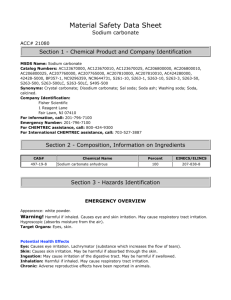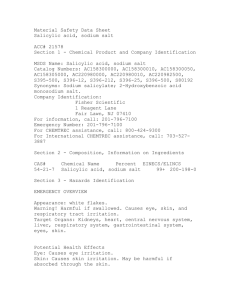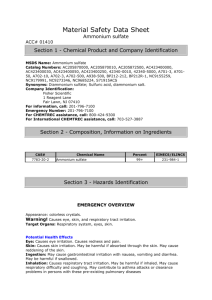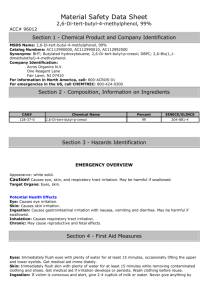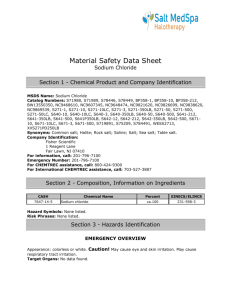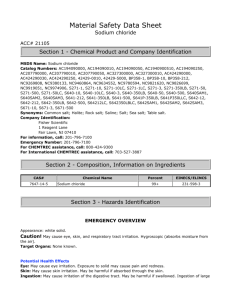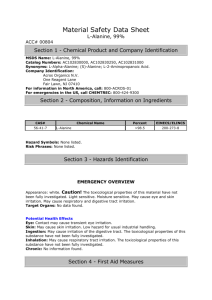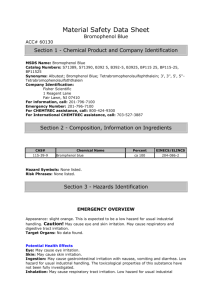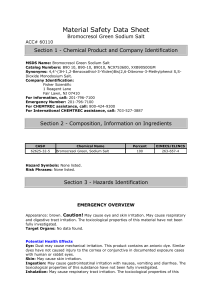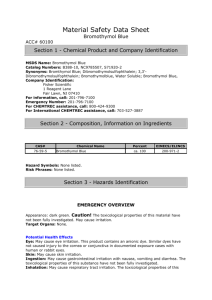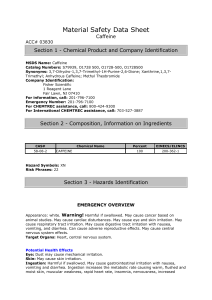Boric acid
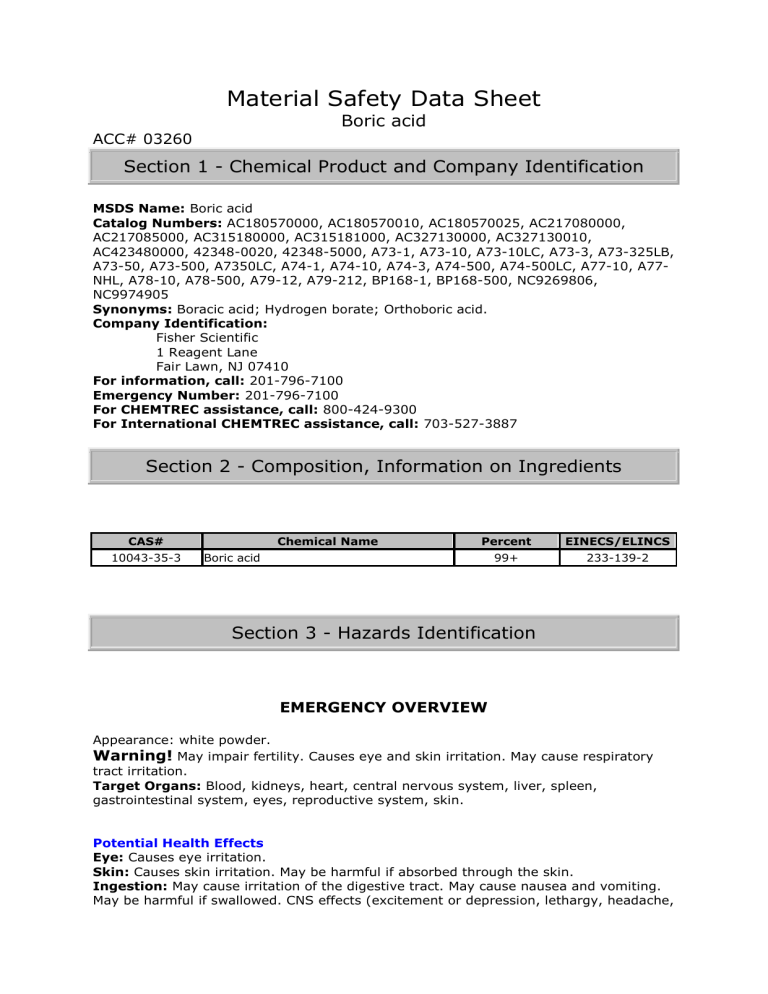
Material Safety Data Sheet
Boric acid
ACC# 03260
Section 1 - Chemical Product and Company Identification
MSDS Name: Boric acid
Catalog Numbers: AC180570000, AC180570010, AC180570025, AC217080000,
AC217085000, AC315180000, AC315181000, AC327130000, AC327130010,
AC423480000, 42348-0020, 42348-5000, A73-1, A73-10, A73-10LC, A73-3, A73-325LB,
A73-50, A73-500, A7350LC, A74-1, A74-10, A74-3, A74-500, A74-500LC, A77-10, A77-
NHL, A78-10, A78-500, A79-12, A79-212, BP168-1, BP168-500, NC9269806,
NC9974905
Synonyms: Boracic acid; Hydrogen borate; Orthoboric acid.
Company Identification:
Fisher Scientific
1 Reagent Lane
Fair Lawn, NJ 07410
For information, call: 201-796-7100
Emergency Number: 201-796-7100
For CHEMTREC assistance, call: 800-424-9300
For International CHEMTREC assistance, call: 703-527-3887
Section 2 - Composition, Information on Ingredients
CAS#
10043-35-3 Boric acid
Chemical Name Percent
99+
EINECS/ELINCS
233-139-2
Section 3 - Hazards Identification
EMERGENCY OVERVIEW
Appearance: white powder.
Warning!
May impair fertility. Causes eye and skin irritation. May cause respiratory tract irritation.
Target Organs: Blood, kidneys, heart, central nervous system, liver, spleen, gastrointestinal system, eyes, reproductive system, skin.
Potential Health Effects
Eye: Causes eye irritation.
Skin: Causes skin irritation. May be harmful if absorbed through the skin.
Ingestion: May cause irritation of the digestive tract. May cause nausea and vomiting.
May be harmful if swallowed. CNS effects (excitement or depression, lethargy, headache,
coma, seizures), dehydration, arrhythmias, shock and metabolic acidosis have been reported in extreme adult and pediatric cases.
Inhalation: May cause respiratory tract irritation. May be harmful if inhaled.
Chronic: Prolonged or repeated skin contact may cause dermatitis. May cause liver and kidney damage. Repeated exposure may cause central nervous system damage.
Repeated exposure may cause damage to the spleen. Adverse reproductive effects have been reported in animals. Laboratory experiments have resulted in mutagenic effects.
Chronic exposure may cause blood effects. May impair fertility.
Section 4 - First Aid Measures
Eyes: Immediately flush eyes with plenty of water for at least 15 minutes, occasionally lifting the upper and lower eyelids. Get medical aid.
Skin: Get medical aid. Immediately flush skin with plenty of water for at least 15 minutes while removing contaminated clothing and shoes.
Ingestion: Do not induce vomiting. Get medical aid.
Inhalation: Remove from exposure and move to fresh air immediately. If not breathing, give artificial respiration. If breathing is difficult, give oxygen. Get medical aid.
Notes to Physician: Treat symptomatically and supportively.
Section 5 - Fire Fighting Measures
General Information: As in any fire, wear a self-contained breathing apparatus in pressure-demand, MSHA/NIOSH (approved or equivalent), and full protective gear.
Extinguishing Media: Use water spray, dry chemical, carbon dioxide, or chemical foam.
Flash Point: Not available.
Autoignition Temperature: Not available.
Explosion Limits, Lower:Not available.
Upper: Not available.
NFPA Rating: (estimated) Health: 2; Flammability: 0; Instability: 1
Section 6 - Accidental Release Measures
General Information: Use proper personal protective equipment as indicated in Section
8.
Spills/Leaks: Vacuum or sweep up material and place into a suitable disposal container. Wear a self contained breathing apparatus and appropriate personal protection. (See Exposure Controls, Personal Protection section). Avoid generating dusty conditions. Provide ventilation. Do not let this chemical enter the environment.
Section 7 - Handling and Storage
Handling: Minimize dust generation and accumulation. Do not get in eyes, on skin, or on clothing. Do not ingest or inhale. Use only in a chemical fume hood.
Storage: Store in a cool, dry place. Store in a tightly closed container.
Section 8 - Exposure Controls, Personal Protection
Engineering Controls: Facilities storing or utilizing this material should be equipped with an eyewash facility and a safety shower. Use only under a chemical fume hood.
Exposure Limits
NIOSH OSHA - Final PELs Chemical Name
Boric acid
ACGIH
2 mg/m3 TWA
(inhalable fraction, listed under Borate compounds, inorganic);
6 mg/m3 STEL
(inhalable fraction, listed under Borate compounds, inorganic) none listed none listed
OSHA Vacated PELs: Boric acid: No OSHA Vacated PELs are listed for this chemical.
Personal Protective Equipment
Eyes: Wear appropriate protective eyeglasses or chemical safety goggles as described by OSHA's eye and face protection regulations in 29 CFR 1910.133 or European
Standard EN166.
Skin: Wear appropriate protective gloves to prevent skin exposure.
Clothing: Wear appropriate protective clothing to prevent skin exposure.
Respirators: A respiratory protection program that meets OSHA's 29 CFR 1910.134 and
ANSI Z88.2 requirements or European Standard EN 149 must be followed whenever workplace conditions warrant respirator use.
Section 9 - Physical and Chemical Properties
Physical State: Powder
Appearance: white
Odor: odorless
pH: 3.8 - 4.8 (33g/L aq.sol.)
Vapor Pressure: 2.7 mbar @ 20 deg C
Vapor Density: Not available.
Evaporation Rate:Not available.
Viscosity: Not available.
Boiling Point: Not available.
Freezing/Melting Point:169 deg C
Decomposition Temperature:100 deg C
Solubility: 49.5 g/L @ 20°C
Specific Gravity/Density:Not available.
Molecular Formula:H3BO3
Molecular Weight:61.83
Section 10 - Stability and Reactivity
Chemical Stability: Moisture sensitive.
Conditions to Avoid: Incompatible materials, dust generation, excess heat, exposure to moist air or water.
Incompatibilities with Other Materials: Caustics (e.g. ammonia, ammonium hydroxide, calcium hydroxide, potassium hydroxide, sodium hydroxide), acetic anhydride, alkali carbonates, strong oxidizing agents.
Hazardous Decomposition Products: Carbon monoxide, carbon dioxide, oxides of boron.
Hazardous Polymerization: Will not occur.
Section 11 - Toxicological Information
RTECS#:
CAS# 10043-35-3: ED4550000; ED4560000
LD50/LC50:
CAS# 10043-35-3:
Oral, mouse: LD50 = 3450 mg/kg;
Oral, rat: LD50 = 2660 mg/kg;
Oral, rat: LD50 = 2500 mg/kg;
.
Carcinogenicity:
CAS# 10043-35-3: Not listed by ACGIH, IARC, NTP, or CA Prop 65.
Epidemiology: No information found
Teratogenicity: Teratogenic effects have occurred in experimental animals.
Reproductive Effects: Adverse reproductive effects have occurred in experimental animals.
Mutagenicity: No information foundMutation in microorganisms:See actual entry in
RTECS for complete information.
Neurotoxicity: No information found
Other Studies:
Section 12 - Ecological Information
Ecotoxicity: Water flea Daphnia: LC50 = 115.0-153.0 mg/L; 48 Hr.; Static
ConditionFish: Rainbow trout: LC50=150mg B/L; 24-day; Fish: Goldfish: LC50=46mg
B/L; 7-day; Mosquito fish (fresh water) TLm=1800 ppm/24H Mosquito fish (fresh water)
TLm=1800 ppm/24H
Environmental: Boric acid is a water-soluble white powder that may, at high
concentrations, cause damage to trees or vegetation by root absorption.
Physical: No information available.
Other: Do not empty into drains.
Section 13 - Disposal Considerations
Chemical waste generators must determine whether a discarded chemical is classified as a hazardous waste. US EPA guidelines for the classification determination are listed in 40
CFR Parts 261.3. Additionally, waste generators must consult state and local hazardous waste regulations to ensure complete and accurate classification.
RCRA P-Series: None listed.
RCRA U-Series: None listed.
Section 14 - Transport Information
Shipping Name:
Hazard Class:
UN Number:
Packing Group:
US DOT
Not regulated.
Canada TDG
Not regulated.
Section 15 - Regulatory Information
US FEDERAL
TSCA
CAS# 10043-35-3 is listed on the TSCA inventory.
Health & Safety Reporting List
None of the chemicals are on the Health & Safety Reporting List.
Chemical Test Rules
None of the chemicals in this product are under a Chemical Test Rule.
Section 12b
None of the chemicals are listed under TSCA Section 12b.
TSCA Significant New Use Rule
None of the chemicals in this material have a SNUR under TSCA.
CERCLA Hazardous Substances and corresponding RQs
None of the chemicals in this material have an RQ.
SARA Section 302 Extremely Hazardous Substances
None of the chemicals in this product have a TPQ.
SARA Codes
CAS # 10043-35-3: immediate, delayed.
Section 313 No chemicals are reportable under Section 313.
Clean Air Act:
This material does not contain any hazardous air pollutants.
This material does not contain any Class 1 Ozone depletors.
This material does not contain any Class 2 Ozone depletors.
Clean Water Act:
None of the chemicals in this product are listed as Hazardous Substances under the
CWA.
None of the chemicals in this product are listed as Priority Pollutants under the CWA.
None of the chemicals in this product are listed as Toxic Pollutants under the CWA.
OSHA:
None of the chemicals in this product are considered highly hazardous by OSHA.
STATE
CAS# 10043-35-3 is not present on state lists from CA, PA, MN, MA, FL, or NJ.
California Prop 65
California No Significant Risk Level: None of the chemicals in this product are listed.
European/International Regulations
European Labeling in Accordance with EC Directives
Hazard Symbols:
T
Risk Phrases:
R 60 May impair fertility.
Safety Phrases:
S 45 In case of accident or if you feel unwell, seek medical advice
immediately (show the label where possible).
S 53 Avoid exposure - obtain special instructions before use.
WGK (Water Danger/Protection)
CAS# 10043-35-3: 1
Canada - DSL/NDSL
CAS# 10043-35-3 is listed on Canada's DSL List.
Canada - WHMIS
This product has a WHMIS classification of D2A, D2B.
This product has been classified in accordance with the hazard criteria of the Controlled
Products Regulations and the MSDS contains all of the information required by those regulations.
Canadian Ingredient Disclosure List
CAS# 10043-35-3 is listed on the Canadian Ingredient Disclosure List.
Section 16 - Additional Information
MSDS Creation Date: 5/03/1999
Revision #11 Date: 2/11/2008
The information above is believed to be accurate and represents the best information currently available to us.
However, we make no warranty of merchantability or any other warranty, express or implied, with respect to such information, and we assume no liability resulting from its use. Users should make their own investigations to determine the suitability of the information for their particular purposes. In no event shall Fisher be liable for any claims, losses, or damages of any third party or for lost profits or any special, indirect, incidental, consequential or exemplary damages, howsoever arising, even if Fisher has been advised of the possibility of such damages.
